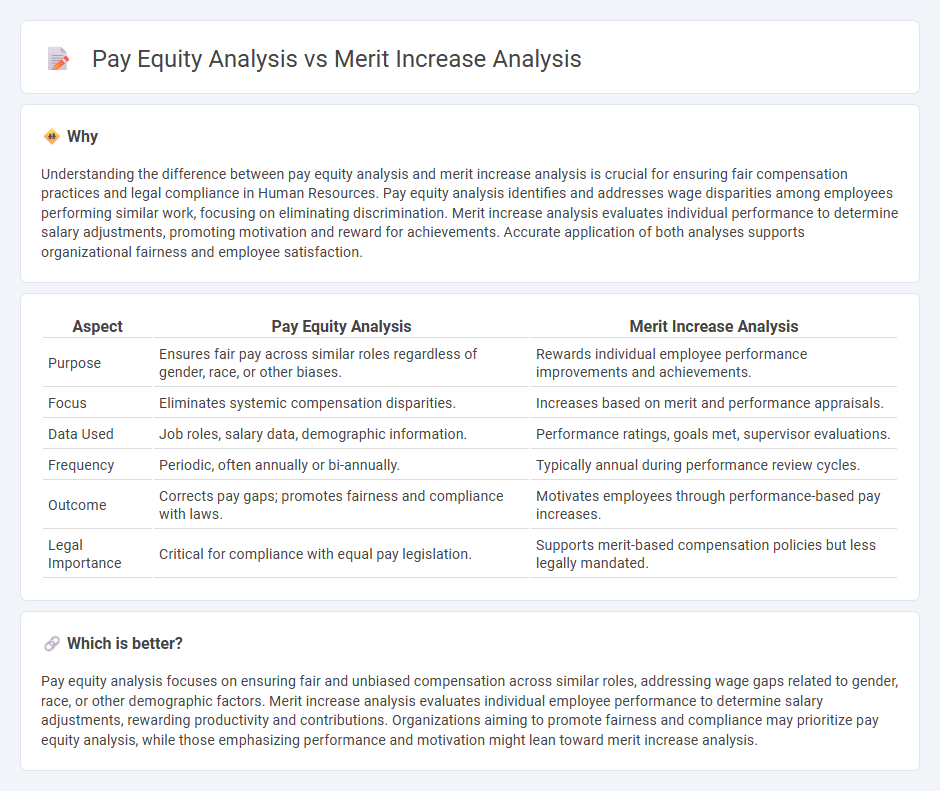
Pay equity analysis examines wage disparities among employees to ensure fairness across gender, race, and other demographics. Merit increase analysis focuses on performance-based salary adjustments that reward individual contributions and drive employee motivation. Explore how these approaches impact compensation strategies and organizational culture.
Why it is important
Understanding the difference between pay equity analysis and merit increase analysis is crucial for ensuring fair compensation practices and legal compliance in Human Resources. Pay equity analysis identifies and addresses wage disparities among employees performing similar work, focusing on eliminating discrimination. Merit increase analysis evaluates individual performance to determine salary adjustments, promoting motivation and reward for achievements. Accurate application of both analyses supports organizational fairness and employee satisfaction.
Comparison Table
| Aspect | Pay Equity Analysis | Merit Increase Analysis |
|---|---|---|
| Purpose | Ensures fair pay across similar roles regardless of gender, race, or other biases. | Rewards individual employee performance improvements and achievements. |
| Focus | Eliminates systemic compensation disparities. | Increases based on merit and performance appraisals. |
| Data Used | Job roles, salary data, demographic information. | Performance ratings, goals met, supervisor evaluations. |
| Frequency | Periodic, often annually or bi-annually. | Typically annual during performance review cycles. |
| Outcome | Corrects pay gaps; promotes fairness and compliance with laws. | Motivates employees through performance-based pay increases. |
| Legal Importance | Critical for compliance with equal pay legislation. | Supports merit-based compensation policies but less legally mandated. |
Which is better?
Pay equity analysis focuses on ensuring fair and unbiased compensation across similar roles, addressing wage gaps related to gender, race, or other demographic factors. Merit increase analysis evaluates individual employee performance to determine salary adjustments, rewarding productivity and contributions. Organizations aiming to promote fairness and compliance may prioritize pay equity analysis, while those emphasizing performance and motivation might lean toward merit increase analysis.
Connection
Pay equity analysis evaluates compensation fairness across different demographics to identify and address wage disparities, ensuring compliance with legal standards. Merit increase analysis assesses individual employee performance to determine appropriate salary adjustments, supporting motivation and retention. Integrating both analyses helps organizations maintain equitable pay structures while rewarding merit, fostering a balanced and compliant compensation strategy.
Key Terms
**Merit Increase Analysis:**
Merit Increase Analysis evaluates employee performance data linked to compensation adjustments, emphasizing individual achievements to drive salary growth within organizational pay structures. This analysis uses performance ratings, market salary benchmarks, and budget constraints to ensure fair and motivating merit-based pay increases. Explore deeper insights into optimizing merit increase strategies for enhanced workforce motivation and retention.
Performance Ratings
Merit increase analysis focuses on evaluating employee performance ratings to determine salary adjustments, ensuring top performers receive appropriate financial rewards. Pay equity analysis examines these ratings alongside demographic data to identify and address disparities in compensation among different groups. Explore more insights on balancing merit-driven pay with equitable compensation strategies.
Salary Adjustments
Merit increase analysis examines salary adjustments based on individual performance metrics to reward high achievers, while pay equity analysis focuses on ensuring fair and equal pay across employees performing similar roles, regardless of demographics. Salary adjustments in merit increase analysis are typically variable and tied to periodic reviews, whereas pay equity adjustments aim to equalize disparities rooted in systemic biases or historical inequities. Explore how these analyses can be integrated to optimize compensation strategies and maintain workforce fairness.
Source and External Links
What is a merit increase and how does it work? - HiBob - This webpage explains the concept of a merit increase, how it differs from general pay raises, and provides formulas for calculating merit increases.
The Ultimate Guide to Merit Increases: How to Reward High Performance - This guide outlines the steps to implement a fair and structured merit raise system, including determining eligibility and establishing performance metrics.
What is a Merit Increase and Why Does it Matter? (2024) - Visier - This blog post discusses using people analytics to determine merit increases, focusing on the financial impact of employee performance and strategic role assessments.
 dowidth.com
dowidth.com